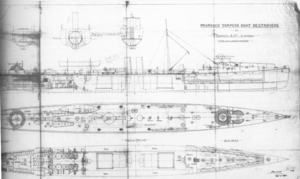HMS Charger (1894) facts for kids

Plans for the Charger class
|
|
Quick facts for kids History |
|
|---|---|
| Name | HMS Charger |
| Builder | Yarrow Shipbuilders, Poplar, London |
| Laid down | November 1893 |
| Launched | 15 September 1894 |
| Completed | February 1896 |
| Fate | Scrapped, 1912 |
| General characteristics | |
| Class and type | Charger-class destroyer |
| Displacement | 255 long tons (259 t) |
| Length | 195 ft (59 m) |
| Beam | 18.5 ft (5.6 m) |
| Draught | 7.25 ft (2.2 m) |
| Propulsion |
|
| Speed | 27 knots (50 km/h; 31 mph) |
| Armament |
|
HMS Charger was a special type of warship called a destroyer that served in the Royal Navy, the United Kingdom's navy. Destroyers are fast, small warships designed to protect larger ships from torpedo boats.
She was built by Yarrow Shipbuilders in Poplar, London, and was launched into the water on 15 September 1894. HMS Charger spent her time serving in the waters around the UK. After many years of service, she was sold in 1912.
Contents
Building a Destroyer: The Charger Class
On 12 October 1893, the British Admiralty (the part of the government that managed the Royal Navy) ordered three new warships. These were called torpedo boat destroyers. The ships ordered were HMS Charger, Dasher, and Hasty.
They were built by the company Yarrow Shipbuilders. These new destroyers were similar to two earlier prototype ships, Havock and Hornet.
What Makes a Destroyer? Design Details
The Admiralty did not give shipbuilders a exact design for these new destroyers. Instead, they gave general rules. These rules included how fast the ship should be (at least 27 knots (31 mph; 50 km/h)), what its front deck should look like (a "turtleback" shape), and what weapons it should carry.
The weapons would change depending on the ship's main job.
- As a torpedo boat: It would have one 12-pounder gun (about 3 in (76 mm) wide) placed on a platform. This platform was also used as the ship's bridge, where the ship was steered. It would also have three smaller 6-pounder guns and two 18-inch (450 mm) torpedo tubes.
- As a gunboat: One of the torpedo tubes could be removed to make space for two more 6-pounder guns.
Size and Power of HMS Charger
Yarrow's design for HMS Charger made her 195 feet 0 inches (59.44 m) long from end to end. Her width, called the beam, was 18 feet 6 inches (5.64 m). When floating, her bottom sat about 11 feet 3 inches (3.43 m) deep in the water, which is called her draught.
The ship's displacement (how much water it pushed aside, which tells you its weight) was 255 long tons (259 t) when empty and 295 long tons (300 t) when fully loaded.
To make her move, HMS Charger had two locomotive boilers. These boilers heated water to make steam at 180 pounds per square inch (1,200 kPa) of pressure. This steam powered two triple-expansion engines. These engines could produce 3,000 indicated horsepower (2,200 kW) of power. The ship had two funnels to let out smoke from the boilers.
Building and Testing HMS Charger
The building of HMS Charger began at Yarrow's shipyard in Poplar, London, in November 1893. She was given the yard number 991.
She was officially launched on 15 September 1894. During her sea trials (tests to see how fast and well she could perform), HMS Charger reached an impressive speed of 27.98 knots (32.20 mph; 51.82 km/h). She was fully finished and ready for service in January 1896. Her total cost was £41,133.
By the time she was finished, older locomotive boilers were being replaced by newer, more efficient water-tube boilers. So, in 1899–1900, HMS Charger was updated at Earle's Shipbuilding. She had her old boilers replaced with water-tube boilers, which also changed her look to have three funnels instead of two.
HMS Charger's Time in Service
In 1896, HMS Charger was kept in reserve at Portsmouth. This meant she was ready to be used if needed but was not actively sailing.
In July 1901, she took part in important Naval Manoeuvres (large training exercises) with other ships. On 11 March 1902, she was officially put into active service at Devonport. Lieutenant Robert William Francis Travers was her first commander in this role.
Later, in April 1902, Lieutenant G. H. Brown took command. HMS Charger was part of a big fleet review at Spithead on 16 August 1902. This event celebrated the coronation of King Edward VII.
On 23 September 1903, HMS Charger accidentally hit some rocks in Loch Nevis, a sea loch on the west coast of Scotland.
Later Years and Retirement
In July 1905, HMS Charger was part of the Chatham Reserve Squadron. She participated in more fleet exercises in the English Channel.
She had another update in 1908 at Sheerness dockyard, where her boiler tubes were replaced. This work was briefly stopped on 27 April when another destroyer, Ribble, was badly damaged in a crash. HMS Charger had to move out of her dock so Ribble could be repaired.
By August 1911, HMS Charger was part of the Sixth Destroyer Flotilla and received another update at Sheerness.
Finally, on 14 May 1912, HMS Charger was sold at Chatham to a company called Ward. They bought her for £1600 to be scrapped (taken apart for materials) at their works in Silvertown.


